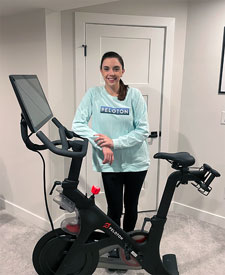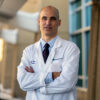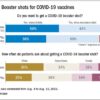Sometimes well-being is as simple as a last-minute bike ride. At the 2021 virtual Pediatric Hospital Medicine (PHM) annual meeting in July, someone on the planning committee asked Mike Tchou, MD, MSc of the University of Colorado and the Children’s Hospital Colorado in Aurora, Colo. to plan a quick group Peloton ride for the conference.
“We got a lot of enthusiasm, a lot of people who enjoyed that,” Dr. Tchou said. “It was just a nice time for our whole field to reconnect. That sort of built some momentum around, ‘Hey, we should see if we can continue this feeling,’ as well as provide a venue for people to have some healthy connections.”
One ride turned to three. Now it’s a weekly event where anyone can join.
Maybe it sounds like a small thing, but the weekly wheels-up is just another new example of how hospitalists are focusing on well-being and avoiding burnout as the prolonged waves of COVID-19 continue to pressure an already overtaxed health care system.
So, what are hospitalists doing to maintain wellness in the face of full hospitals, long shifts, and few breaks?
Working on burnout and fulfillment
Back in November 2020, as the winter wave ramped up, a trio of hospitalists at Cleveland Clinic Children’s in Cleveland, Ohio, finally had enough data in place to run a quality improvement (QI) project to measure and address burnout and fulfillment.
The goal was to decrease burnout among the group to 10% and raise fulfillment to 75%. The results saw burnout levels fall from 20% to 10%, but fulfillment decreased from 54% to 46%.
“We’ve actually had trouble determining why our fulfillment has gone down,” said Colleen Schelzig, MD, FAAP, department chair in pediatric hospital medicine at Cleveland Clinic Children’s. “We were, obviously, thrilled that we made headway on the burnout. And we were able to make some schedule changes and some changes in the work-life balance for our hospitalists. I think that’s why the burnout showed some improvement. But fulfillment is something we continue to look at trying to improve.”
Dana Foradori, MD, M.Ed, FAAP, who chairs Cleveland Clinic Children’s wellness committee, said that undertaking a QI project on burnout and fulfillment in the middle of a pandemic is a sign to hospitalists that it’s not only necessary but important to talk about job pressures.
“Giving them permission to talk about wellness was a huge piece to this project that I think can’t be measured,” she added. “Everybody in the medical profession is struggling right now, and so I wouldn’t be too surprised if that was a confounding factor in our study.”
Julie Cernanec, MD, FAAP, SFHM, medical director for continuous improvement at Cleveland Clinic Children’s, said that while the pressure on hospital medicine right now may seem so big that nothing helps, the opposite is true.
“No intervention is too small,” she said. “If it’s just getting the permission of a departmental or institute chair to not work on your post-call day. It seems like a small thing to get them to say that out loud, but it’s had such a huge impact. Or getting blackout curtains in our call room seems like such a small thing to do, but if that can increase the amount of rest that someone gets on a call night just by 30 minutes, it makes a big difference.”
Let’s go for a ride

Dr. Tina Sosa is a pediatric hospitalist and assistant professor of pediatrics at the University of Rochester Medical Center; she helped Dr. Tchou coordinate regularly scheduled rides. Photo credit Brandon Sosa.
Dr. Tchou started coordinating the regularly scheduled rides with Tina Sosa, MD, a pediatric hospitalist and assistant professor of pediatrics at the University of Rochester Medical Center in Rochester, N.Y.
Now, @PelotonPHM is a Twitter account with 120 followers and a half-dozen riders weekly (with room for more, Dr. Tchou noted with a smile).
“There’s a huge value just in seeing someone you know who you would normally see a few times a year at conferences, on the app,” he added. “Whether it’s a dopamine rush or something like that when they high-five you, or just seeing their name on the leaderboard, it just makes the exercise feel more meaningful.
“I think also, a lot of us are just trying to get out there and be healthier and prioritize wellness…we don’t often take time for ourselves in general, but especially when we’re busy hospitalists and in the middle of different surges in the pandemic, carving a little time for yourself where you get a little exercise in feels kind of doubly impactful.”
Drs. Tchou and Sosa are working on ways to increase ridership and engagement—treating the rides like a QI project. Ideas include creative scheduling of classes, creative prizes for attendance, or even formal competitions. Maybe an annual prize could be giving away a Peloton itself, Dr. Tchou joked (unless @onepeloton is reading, and then his email is [email protected]).
“I think our goal is how we can continue this as long as possible and engage the most people as possible in whatever ways make it most beneficial for them,” he said. “It may evolve over time. Maybe it’ll turn into five or six smaller groups who can tailor their schedules more. Either way, hopefully, we can keep the momentum going because people have enjoyed it so far.”
Taking wellness to task
Over the last 18 months, SHM’s Well-Being Task Force formed and focused on the day-to-day activities hospitalists and hospital medicine leaders can do to support each other.
Now, the task force is looking to the future.
“What sorts of programs and training can we create?” said Read G. Pierce, MD, hospital medicine division chief, associate professor, and associate chair for faculty development and well-being at Dell Medical School in Austin, Texas. “What sort of content can we create for individuals in hospital medicine who want to be a well-being champion or a well-being leader within their groups? We’re just at the beginning of that work, and I think it’s going to unfold in a lot of cool ways. This is about capacity building, more than just crisis response.”
First, Dr. Pierce sees the task force creating “a roadmap for leadership skills that help promote well-being so that people are who are interested in becoming well-being champions can bring this into how they approach their work over time as leaders.”
Second, Dr. Pierce hopes to build a well-being network where like-minded colleagues can connect. And lastly, he foresees the task force presenting a recommendation to SHM on what it “can build in terms of infrastructure to make hospital well-being a key strategic focus for the next five to 10 years. If we can do those things, it’ll be a great contribution.”
As a first step, SHM’s well-being website has links to three burnout intervention tools:
- COVID-19 Check-in Guide for Self & Peers, which was the group’s first resource.
- AMA STEPS Forward module for hospitalists, including a five-step process to address well-being developed by SHM in collaboration with the American Medical Association (AMA) and the American College of Physicians (ACP).
- American Hospital Association (AHA) Well-Being Playbook, which offers seven steps leaders can take to promote wellness.
To Dr. Pierce, wellness isn’t just about daily living. It’s about the future of the field.
“If we put this on the periphery of what we’re working on, we’re going to have a lot of people leave,” he said. “We’re going to have a lot of people cut back their discretionary effort. And our ability to be creative and innovative is really going to dissipate because people are too tired.
“One of the things that makes hospitalists great, in my opinion, is the fact that we’ve been multidimensional…I personally think that attention to the well-being of the hospitalist workforce is the thing that is going to make or break our capacity to be an innovative field over the next decade.”

